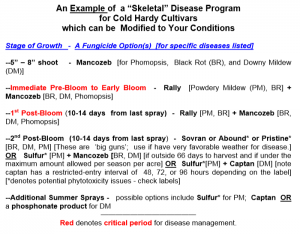After one of the driest Mays on record, we are closing out June as one of the wettest in many areas, and that means the potential for diseases in Vermont vineyards. Recent weather has been excellent for development of our major diseases: phomopsis, black rot, powdery mildew, downy mildew, and anthracnose. I have often relied upon my predecessor Dr. Lorraine Berkett’s recommended initial vineyard IPM program to get us through spring and early summer, but the past few weeks would likely test that minimal approach. Here’s a recap of those recommendations:

By now, growers should be at or approaching the second post-bloom application, and I do not recommend skipping this one. Since this was written in 2009, several other fungicides have been released that may replace Sovran/ Abound or Pristine on the program, including Revus Top and the two Luna products (Experience & Tranquility). Please refer to the 2015 New York and Pennsylvania IPM Guidelines for Grapes for specific materials and rates, or contact me directly with specific questions. Also, consider shortening intervals when excessive excessive rain has fallen: the rule of thumb is that 2″ of rain washes off all fungicide protection, and newly emerged leaves since the last application will have only minimal fungicide coverage from redistribution of weathered, previously applied sprays. Organic growers who are relying on copper, sulfur, and/or biofungicide materials this season should be really tightening their schedules, and planning carefully scouting for and removing disease infected foliage and fruit. The good news is that within a couple of weeks berries will be building resistance to black rot, but downy and powdery mildew and botrytis still demand attention.
The main insects of concern are rose chafers and foliar phylloxera, although the latter are not something I would be too concerned about. Again, specific materials for use against these pests are listed in the NY/PA guide. Growers often use carbaryl against foliar-feeding beetles like rose chafer and Japanese beetle, but in many cases, tolerance is also effective as long as foliage feeding doesn’t get too overwhelming (and less tolerance should be given on young vines).



